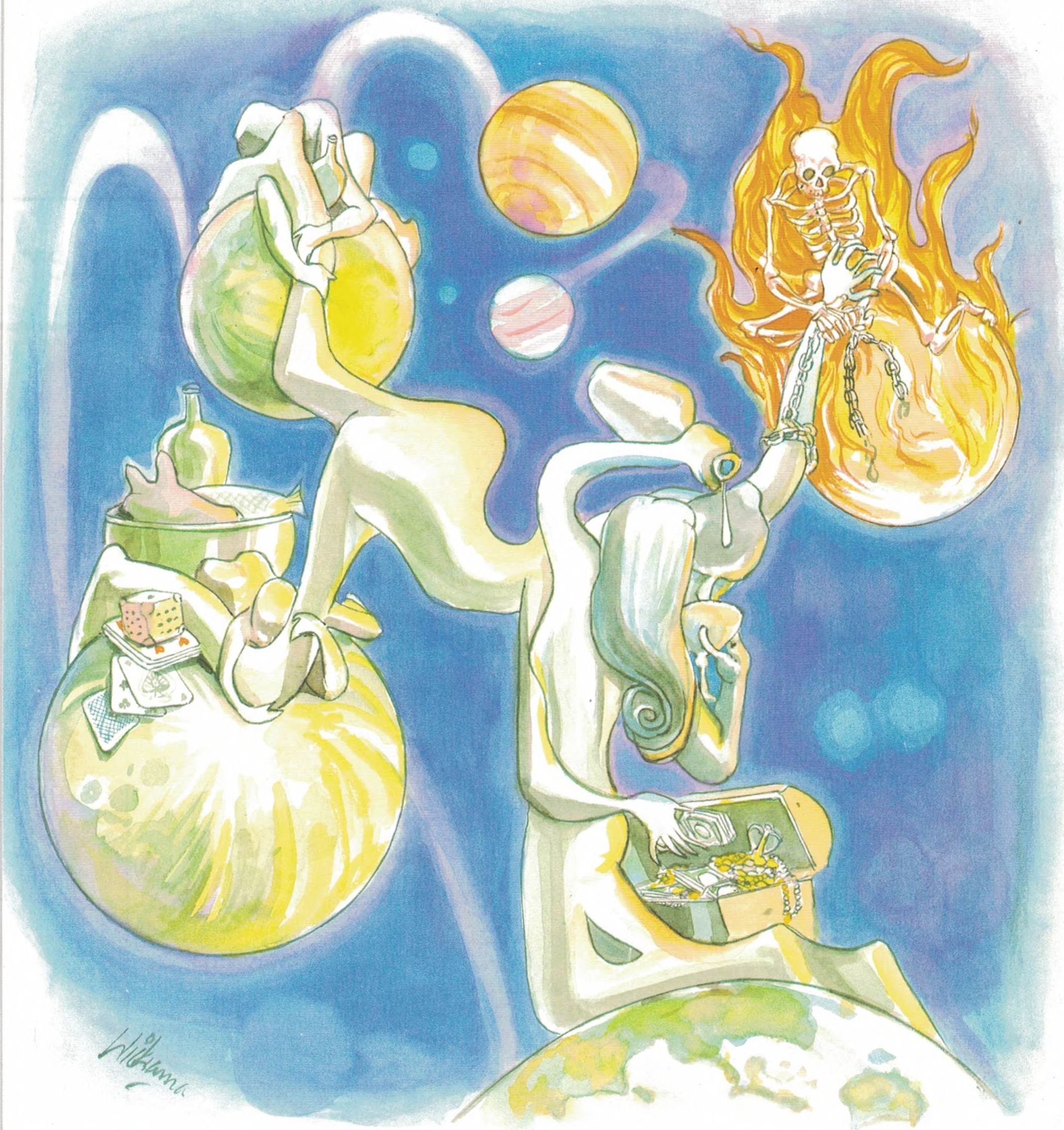Dhammapada (Illustrated)
by Ven. Weagoda Sarada Maha Thero | 1993 | 341,201 words | ISBN-10: 9810049382 | ISBN-13: 9789810049386
This page describes The Story of a Young Monk which is verse 167 of the English translation of the Dhammapada which forms a part of the Sutta Pitaka of the Buddhist canon of literature. Presenting the fundamental basics of the Buddhist way of life, the Dhammapada is a collection of 423 stanzas. This verse 167 is part of the Loka Vagga (World) and the moral of the story is “No Depraved Vision, No Heedlessness, And No Low Pursuits For Worldly Gains”.
Verse 167 - The Story of a Young Monk
Pali text, illustration and English translation of Dhammapada verse 167:
hīnaṃ dhammaṃ na seveyya pamādena na saṃvase |
micchādiṭṭhiṃ na seveyya na siyā lokavaddhano || 167 ||
167. Do not follow base desires, nor live with heedlessness, do not follow wrong beliefs to grow in worldly ways.
 No depraved vision, no heedlessness, and no low pursuits for worldly gains. |
The Story of a Young Monk
While residing at the Jetavana Monastery, the Buddha spoke this verse, with reference to a young monk.
Once, a young monk accompanied an older monk to the house of Visākhā. After taking rice gruel, the elder monk left for another place, leaving the young monk behind at the house of Visākhā. The granddaughter of Visākhā was filtering some water for the young monk, and when she saw her own reflection in the big water pot she smiled. Seeing her thus smiling, the young monk looked at her and he also smiled. When she saw the young monk looking at her and smiling at her, she lost her temper, and cried out angrily, “You, with a shaven head! Why are you smiling at me?” The young monk retorted, “You are a shaven head yourself: your mother and your father are also shaven heads!” Thus, they quarrelled, and the young girl went weeping to her grandmother. Visākhā came and said to the young monk, “Please do not get angry with my grand-daughter. But, a monk does have his hair shaved, his finger nails and toe nails cut, and putting on a robe which is made up of cut pieces, he goes on alms-round with a bowl. What this young girl said was quite right.” The young monk replied, “It is true, but why should she abuse me on that account?” At this point, the elder monk returned: but both Visākhā and the old monk failed to appease the young monk and the young girl who were quarrelling.
Soon after this, the Buddha arrived and learned about the quarrel. The Buddha knew that time was ripe for the young monk to attain sotāpatti fruition. Then, in order to make the young monk more responsive to his words, he seemingly sided with him and said to Visākhā, “Visākhā, what reason is there for your granddaughter to address my son as a shaven head just because he has his head shaven? After all, he had his head shaven to enter my order, didn’t he?” Hearing these words, the young monk went down on his knees, paid obeisance to the Buddha, and said, “Venerable! You alone understand me: neither my teacher nor the great donor of the monastery understands me.” The Buddha knew that the monk was then in a receptive mood and so he said, “To smile with sensual desire is not right and it is improper to have ignoble thoughts.” At the end of the discourse, the young monk attained sotāpatti fruition.
Explanatory Translation
hīnaṃ dhammaṃ na seveyya pamādena na saṃvase
micchādiṭṭhiṃ na seveyya lokavaḍḍhano na siyā
hīnaṃ [hīna]: depraved; dhammaṃ [dhamma]: ways of life, traits; na seveyya: do not cultivate; pamādena: slothfully; na saṃvase: do not live your life; micchādiṭṭhiṃ [micchādiṭṭhi]: false views; na seveyya: do not turn to; lokavaḍḍhano [lokavaḍḍhana]: a cultivator of the world; na siyā: do not be
Stoop not to depraved ways, to practices that promote lower urges. Do not live slothfully. Do not associate yourself with those who hold false views.
Commentary and exegetical material (Verse 167)
micchādiṭṭhiṃ na seveyya: do not embrace false views. These are views that go against the Teaching of the Buddha–against Dhamma. Those who take to false views can be described as treading the false path–micchā-magga which is atthangika:
The eightfold wrong path, i.e.,
- wrong view (micchā-diṭṭhi)
- wrong thought (micchā-sankappa):
- wrong speech (micchā-vācā):
- wrong bodily action (micchā-kammanta):
- wrong livelihood (micchā-ājiva):
- wrong effort (micchā-vāyāma):
- wrong mindfulness (micchā-sati):
- wrong concentration (micchā-samādhi).
Just as the eight-fold right path (sammā-magga), so also here the eight links are included in the group of mental formations (sankhāra-kkhandha). The links 2, 6, 7 and 8 are inseparably bound up with every kammically-unwholesome state of consciousness. Often are also present 3, 4, or 5, sometimes link 1.
Special Note: Of those religious persons who held false views in the Buddha’s days, six are very well known.
Their names and the systems they professed are given below:
- Pūrana Kassapa–akiriya vāda (doctrine of inefficacy);
- Ajitha Kesakambala–uchcheda vāda (materialist doctrine of annihilationism);
- Pakuda Kaccāyana–akrunktatavāda (nihilism);
- Makkhali-Gosāla–daiva vāda (fatalism);
- Sanjaya Bellaṭṭhiputta Amarāvikkhepa vāde–anischita vāda (doctrine of rational scepticism);
- Niganthanāthaputta–chātuyāma saṃvara vāda (doctrine of Ahimsā).
Of these six teachers, information regarding four, i.e., Pūrana Kassapa, Ajitha Kesakaṃbala, Pakuda Kachchāyana and Sanjaya Bellaṭṭhiputta, is given in the Sāmaññaphala Sutta of the Dīghanikāyā. Information regarding the other two is given in both Jaina and Buddhist literature.
The teachings of these six teachers can be divided into two categories:
- Asthika Vāda (Belief in the existence of the soul and the next world):
- Nāsthika Vāda (Non-belief in a soul and the next world, and in the results of good and bad deeds).
